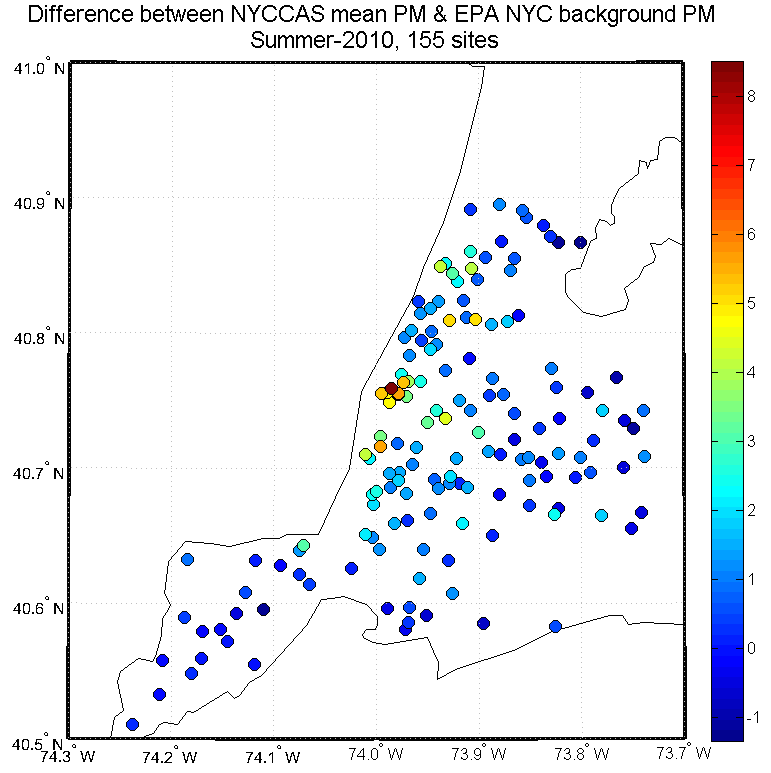Data fusion of Satellite AOD and WRF meteorology for improved PM25 estimation for northeast USA
Monday, 5 January 2015: 1:45 PM
at Sixth Conference on Environment and Health)
228AB (Phoenix Convention Center - West and North Buildings)
The current approach to ingesting satellite data (IDEA- Infusing satellite Data into Environmental air quality Applications Product) into surface PM2.5 retrievals uses a combination of spatial interpolation and a global geo-chemical model (GEOS-CHEM) to define appropriate mass to AOD factor maps that can be used with satellite AOD retreivals. This information is then statistically blended with current AIRNow measurements creating a refined retrieval product. In this paper, we propose to use the same approach except that we replace the GEOS-CHEM component with an alternative high resolution meteorological model scheme. In particular, we illustrate that the GEOS-CHEM factors can be strongly biased and explore methods that incorporate a combination of satellite AOD retrievals with WRF meteorological forecasts on a regional scale. We find that although PBL height should be a significant factor, the WRF model uncertainties for PBL height in comparison to Calipso make this factor less reliable. More directly we find that the covarying PBL averaged temperature (together with wind direction) are the most important factors. Direct statistical comparisons are made against the IDEA product showing the utility of this approach over regional scales. In addition, we explore the importance of a number of factors including season and time averaging showing that the satellite approach improves significantly as the time averaging window decreases illustrating the potential impact that GOES-R will have on PM25 estimation.
.
Fusing Spatial Kriging with Satellite Estimates to Obtain a Regional Estimation of PM2.5
Sunday, 4 January 2015 (Student Conference Poster Session, 14th Annual Student Conference)
This work focuses on developing estimates of ground-level fine particulate matter (PM2.5) in the northeastern U.S. based on measurements derived from the Air Quality System (AQS) repository. Real time monitoring of PM2.5 is important due to its effect on climate change and human health, however, designated samplers used by state agencies do not provide optimal spatial coverage given their high cost and extensive human labor dependence. Through the application of remote sensing instruments, information about PM2.5 concentrations can be generated at certain locations. On the other hand, coverage limitation also occurs when using satellite remote sensing methods due to atmospheric conditions. Therefore, our approach begins by utilizing surface PM2.5 measurements collected from the Remote Sensing Information Gateway (RSIG) portal in order to build fine particulate matter estimations by applying a Spatial Kriging technique. Then, we combine our Kriging estimations to the satellite derived PM2.5 obtained through an Artificial Neural Network (ANN) scheme to generate a daily regional PM2.5 product. Finally, evaluation of our fused algorithm's technique is assessed by performing comparisons against Kriging and neural network individual performances, showing the promising value added by the combination of these two techniques in producing more accurate estimations of surface level PM2.5 over our region of interest.
This one is related to the award winning work by Daniel:
Analysis of New York City traffic data, land use, emissions and high resolution local meteorology for the prediction of neighborhood scale intra-urban PM2.5 and O3
Monday, 5 January 2015: 4:30 PM
at Sixth Conference on Environment and Health)
228AB (Phoenix Convention Center - West and North Buildings)
Air pollution affects the health and well-being of residents of mega cities like New York. Predicting the air pollutant concentration throughout the city can be difficult because the sources and levels of the pollutants can vary from season to season. Local meteorology, traffic and land use also play an important role in these variations and the use of statistical machine learning tools such as Neural Networks can be very useful. In order to develop a Neural Network for the prediction of intra-urban air pollutants (PM2.5, O3), high resolution local data are collected and analyzed. Surface level high resolution temperature, relative humidity and wind speed data are collected from the CCNY METNET network. Annual average daily traffic data from NYMTC model as well as continuous and short count traffic data are collected from NYSDOT. High density data from NYC Community Air Survey model is used to analyze the relationship between background and street level indicators for PM2.5 and O3. All the variables (meteorology, population, traffic, land use etc) are ranked according to the absolute strength of their correlation with the measured pollutants and highest ranking variables are identified to be used for the development of a Neural Network. An analysis of how street level pollution differs from background AIRNow observations will be made showing the importance of high density observations. The potential to use the model in other urban areas will also be explored.
Having now relocated to NASA JPL, it is fun to reflect back to see what was accomplished during my stay at CCNY.






















